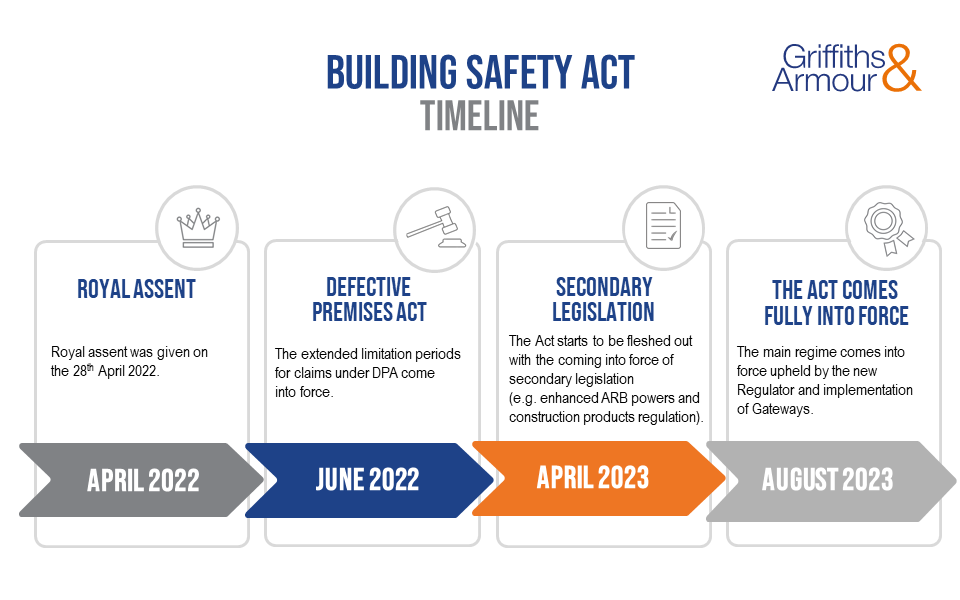Building Safety Act (BSA) Headlines
The scope of the BSA is extraordinarily wide and few will remain untouched by the changes it brings. Major factors include:
- the introduction of a new regulator dealing with building safety;
- new duties and roles in respect of ‘higher risk buildings’;
- extended liability periods that will apply to claims under the Defective Premises Act;
- the coincidental implementation of s.38 of the Building Act;
- enhanced powers for the Architects Registration Board; and
- the implementation of the main safety regime, approval gateways and the ‘golden thread’.
- The ambition of the BSA constitutes enormous, almost breathless change.
It is also clear that the detail behind these changes is still far from fleshed out and there is an expectation that the coming months will bring more clarity as to the practical changes that the Act will require industry to make. The expectation is that those changes will need to be profound, both in technical and, perhaps even more critically, cultural terms.
The need for a substantive period of transition is reflected in the Government timeline for the full implementation of the BSA, which envisages parts of the Act coming in force over a period of at least 18-months:

A summary of the main changes
At this point, there is much detail we don’t yet know; it’s hard to summarise just what some of the implications of the legislation will be. There are, however, some discrete areas of theBSA where the position has been well signposted; we already know that there are a number of noteworthy areas where the BSA introduces new liabilities and expands others:
1. Changes made to the Defective Premises Act (DPA)
Although until recently a relatively uncommon sighting in construction Professional Indemnity (PI) claims, the main obligation imposed by the DPA is that contractors, engineers, architects (and others) are under a statutory duty to see that the work they undertake in relation to the provision of a dwelling is done in a professional (or workmanlike) manner, so that the dwelling is fit for habitation when finished. If it isn’t, then the owner of the dwelling could bring a claim against those responsible.
What’s changed?
- Refurbishments to be covered
Prior to the BSA, claims under the DPA were only possible in respect of the construction or conversion of a dwelling, but not any aspects of refurbishment, even major refurbishment. The BSA changes this position so that (on a prospective basis only) refurbishments will be brought within scope of the new DPA regime. - Limitation periods – unbarring claims
The original DPA provided that a claim must be brought within 6 years of the completion of the work. Prior to the most recent changes to the BSA, the intent was to extend this to a 15-year period – a substantial extension of the limitation period and a potentially worrisome development for consultants and their insurers.
The new DPA in fact now introduces two new limitation periods in respect of:
- Work already completed prior to the Building Safety Act: The changes allow DPA claims for a period of 30 years from the completion of the work, which applies on a retrospective basis. This means that claims under Section 1 of the DPA are now un-barred in relation to dwellings completed from the early 90s.
This element only applies to ‘new’ dwellings, as the change to the DPA in respect of refurbishments under the legislation does not have retrospective effect. - Future work: Work completed post-BSA will attract a 15-year limitation period, commencing on completion of the work, which will now cover both new build and refurbishment.
Impact
Importantly, the claimant still needs to show that the work made the dwelling unfit for habitation and that determination would be for a court to decide. This is generally regarded as a ‘high bar’ for the claimant to meet, though it is worth remembering that the liability under the DPA is widely regarded as being ‘strict’.
Therefore, it might not be a defence to argue that ‘due care’ was taken in order to deliver a dwelling that was fit for habitation. If the claimant can show the dwelling is ‘unfit’ then the question of a breach of a duty of care is likely to be irrelevant.
A further aspect of the strict nature of the liability might be that defendants can’t argue that they were simply following established practice at the time they undertook the work. The claimant needs only to show to the court that the dwelling was not fit for habitation as a result of the work that was done. This could have consequences in relation to defending ‘cladding claims’ under the DPA and time will tell what impact this will have.
It is also worth noting that liability under the DPA cannot be limited or excluded in contract.
At Griffiths & Armour it is our view that there are two main aspects to consider with this change. The first is the message it sends to those underwriting construction PI risks. That message is, put simply, that the established legal norms and limits around liability are in a state of flux. There is a real worry to what extent Government might be forced to make other retrospectively applicable changes.
Second, there is the question of finance. Just how much more money do underwriters need in order to meet claims under the DPA for not just the last 6, or even 15-years, but the last 30-years?
We don’t believe anyone really understands the potential impact, in financial terms, of the proposed changes to the DPA regime on the PI insurance sector. That it could lead to more claims and greater cost seems likely, but just how much greater is unknown. We do know that the incidence of claims under the DPA is rising, admittedly from a negligible level, but there will now be an even longer ‘tail’ attached to those claims.
What is now already clearly apparent is the non-financial impact of the Government’s changing position. Insurers are becoming very nervous of what else might change and how their exposures could be yet again re-written by further retrospective changes in legislation. That worry could well translate into a prolonged period of uncertainty in the PI market. For any insurer thinking of re-entering the market, they will very likely need to do some more thinking and lobbying internally to argue that the PI market is worth their investment.
As noted above, firms cannot limit or exclude liability for claims under the DPA, and there is the further complication that there is no guarantee that the insurance market will continue to cover the extended periods the DPA now provides for. That is an area which we intend to monitor carefully.
The practical consequence is that there is little any one individual firm can do to prepare for the fallout of these changes. With that in mind, we will continue to work with and provide our technical support to like-minded bodies to argue for substantial and fair change.
2. Construction products claims
It has been a feature of many of the cladding projects under scrutiny in recent years that certain product manufacturers have faced significant criticism because of allegations that their products were either inherently defective, non-compliant with the relevant regulations, and/or the product specifications that were put out were misleading.
Ordinarily, manufacturers might well be facing a significant volume of claims but for the fact that in practice successfully claiming against them has proven difficult and costly. The chief difficulty has been that most of the contracts under which their products were procured were placed by sub-contractors (often many tiers down in the supply chain). Largely because of the contracts that were agreed, and just as often the fact that the relevant sub-contractor no longer exists, has meant that claims by those people living in the affected buildings are difficult (if not impossible) to sustain.
What’s changed?
The BSA seeks to change this position by creating an entirely new cause of action against construction product manufacturers and other operators (such as those distributing such products) for those with a legal or equitable interest in a dwelling, if they can show that the product fails:
- to comply with a statutory requirement,
- is inherently defective, or
- if a misleading statement has been made in relation to the product.
- This will apply in England, Wales, Scotland and Northern Ireland.
This would allow those who own an affected dwelling to recover costs for damage to their property, or for economic loss.
As with the DPA, limitation periods will be introduced which are longer than the norm. In relation to ‘cladding products’ a retrospective 30-year period is being introduced, which opens up product manufacturers to claims dating back to the early 1990s. In relation to all other construction products, a 15-year period will be introduced, which will only apply prospectively.
Impact
This is a significant extension of a construction manufacturer’s and distributor’s liability and it could give rise to widespread litigation. As the right of action could be brought by anyone who has a legal or equitable interest in a dwelling (or the building), developers too might well utilise it to recover some of their own costs.
It is probably too early to say whether this is a positive or negative development for professionals. On the one hand, the ability for those affected to be able to bring claims against the culpable manufacturers, where previously a claim would have been impossible ought to be positive. The result could be that those most culpable should shoulder the blame. On the other hand, this could be a source of further litigation into which professionals could ultimately be drawn.
3. Section 38 Building Act 1984
Alongside the Building Safety Act, the Government will also bring into force this long dormant, but potentially very important, section of the original 1984 Building Act. S38 provides for civil claims to be made in respect of physical damages/losses caused by a breach of the building regulations and applies to all buildings in England and Wales.
The right to claim under s.38 does not appear to be restricted to homeowners so it seems likely that it allows parties to claim who are not in contract with those they believe are responsible and could provide for ‘contractor v. consultant’ claims.
What’s changed?
With s.38 brought into force, this means that a homeowner (and others) can seek compensation for damage caused by building work not meeting the relevant regulations at the time the work was done.
In addition to ‘activating’ this section, the Government are increasing the time in which claims may be made to 15-years from the completion of the works (on a prospective basis).
Impact
It is interesting to note that an earlier draft of the Building Safety Act provided for this section to be repealed, which did excite some industry comment at the time, particularly given the Grenfell Inquiry finding many breaches of the Building Regulations in an earlier phase of its reporting. It is telling of the current direction of travel of the Department for Levelling Up, Housing and Communities (DLUHC) that not only has the provision been reversed, but they have also sought to remedy at least some of the perceived ‘holes’ in s.38, particularly the limitation period and the problem of insolvent ‘special purpose vehicles’.
That said, the prospective nature of these changes will likely mean there is no immediate impact, and its introduction is very unlikely to mean that works pre-dating its commencement would be within scope.
Going forward, claims under s.38 could become a notable feature of the insurance landscape. It is too early to say whether this simply means it will be easier to identify claims relating to breaches of building regulations, given that those claims are at the moment largely ‘hidden’. This is because such claims are still advanced now, but the claim itself typically arises from a breach of contract to comply with the regulations and therefore little hard data exists on the volume of those claims.
A further ‘brake’ on its importance is that there has been no clarification as to whether s.38 includes claims for pure economic losses. Although there are some legal commentators that say economic loss could be covered by the Building Act, the Government explanatory paper makes it clear that physical damage or injury is required. As with many aspects of the new regime, we will need the Courts to interpret and clarify the position. Suffice it to say for now, there is little doubt the activation of s.38 and the supporting measures have the potential to act as a significant catalyst for more litigation going forward.
Some final thoughts
The thread running through these legislative changes is that the liability environment of the future could be significantly worse than the past, particularly if the overarching aim of the BSA isn’t met; i.e. a fundamental culture change.
If the quid pro quo of accepting this additional liability is that contractors, consultants and everyone involved in the design and construction of the built environment is encouraged (and perhaps forced) to work more collaboratively, avoid disputes and produce high quality and safe buildings, then that’s a price we think most would believe is worth paying.
We believe that the insurance industry and indeed many of our clients would be prepared to underwrite their equitable share of those additional liabilities: if the corollary of that were a fairer overall liability environment in which ‘risk dumping’ on those least able to afford it were to become a thing of the past; if the commercial environment where that innovation, creativity and quality were recognised, championed and rewarded; if insurance requirements were fair and proportionate; if those purchasing PI insurance weren’t viewed as an extension of a project’s balance sheet.
If that culture doesn’t change, or if as Hackitt said ‘quick and cheap’ is still the goal, and we simply overlay additional liabilities on the current model, then the BSA lays the foundation stones of a profoundly difficult future.
And what of the insurers? Initial reaction to the legislation has been generally very positive. However, that is predicated on real change being driven through the industry. In the coming months, we’ll need to carefully gauge insurers developing perspective and manage some detailed engagements. For now, we are aware of no insurers making (or preparing to make) any policy adjustments because of the BSA but this is obviously an area which will require close monitoring over the coming years as the true impact of the new legislation becomes clear.
If you have any questions about the contents of this article, please complete the form below this article or click here to submit your enquiry to Executive Director (Professional Risks), Craig Roberts, who will be happy to assist.
Craig has spent the last 20 years, throughout his time with Griffiths & Armour, advising firms responsible for designing and constructing the built environment on their professional risk exposures and what to do about them. As a Law graduate and Associate of the Chartered Insurance Institute, his advisory work has seen him actively involved with a broad spectrum of Griffiths & Armour client interests – from the largest construction companies to institutional SME professional forums.
Craig advises professional bodies, institutions and Government on PI insurance issues and he regularly writes on subjects concerning PI insurance and construction. In recent times the focus has been in support of efforts to solve an apparently unsolvable puzzle – the legacy associated with existing high rise cladded buildings; wider fire safety issues and associated regulatory change.
Craig is an acknowledged authority on today’s risk exposures for the construction professions. He was the principal author of Griffiths & Armour’s most recent risk education publication, ‘A Brave New World: Navigating Future Challenges’, which takes a wider view of the market challenges facing construction consultants. He has liaised closely with our own industry body, BIBA, around their Manifesto promise to ‘…work closely with Government to find shared solutions… to the severe problem with the availability of adequate PII cover in respect of fire safety risks’. In this capacity, Craig’s work has been to assist BIBA with the drafting of a range of submissions aimed at securing a better liability environment for all those working in construction.










